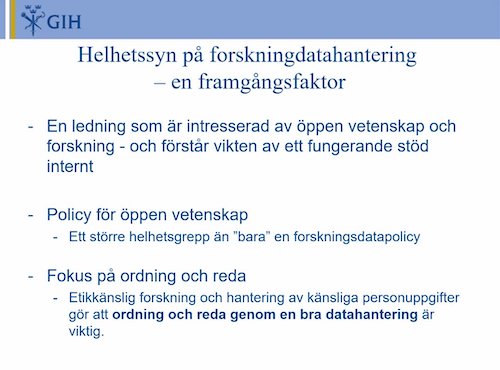The establishment and development of support functions for research data, also known as DAU (Data Access Units), is well under way among members of the SND network. But even though we’re all working towards a common goal – to create conditions that enable researchers to manage and share research data in a safe and sustainable way – the ways to get there can be very different. In SND’s latest network meeting, some HEIs shared their experiences of this work.
A research data support function in an HEI consists of two to nine people, is often centred around the university library but with involvement from other parts of the organisation, such as the Research Office, IT services, the archive, and the legal officers. The support function devotes a large share of their time to informing researchers about requirements and guidelines to data management. Many issues that arise involve how to relate to the General Data Protection Regulation. That’s how Andreas Hellgren from Stockholm School of Economics summarised some of the responses from a survey from their DAU about the organisation of support functions in other HEIs in the SND network. Before the final report from their DAU project, the group wanted to provide some suggestions to how the support function’s work could be structured and organised ahead and wanted to know how other DAU functions have done.
Turning to others and daring to ask for their help is something that Ulrika Nyman from Mälardalen University urged the other DAU staff to do.
—If I could do it all over again, I would’ve invited others sooner. During this work, I’ve collaborated with both internal and external staff to ask for their help. It’s scary at first, because you don’t want to ask stupid questions. But everyone’s been very kind and care for one another. So dare to ask for more help!
Ulrika Nyman said that the establishment of a DAU in Mälardalen University has coincided with a major organisational change that have brought together representatives from various parts of the university in large common meetings. It’s been positive, she says, to create a sense of working together, and has created links between functions at the university that have a different understanding of the field of research data.
Success factors and challenges

success factors in establishing a research data support function.
When the present HEIs were asked to give examples of success factors, Malin Ekstrand from the Swedish School of Sport and Health Sciences (GIH) mentioned that a holistic approach had been important for them. She said that they had benefited from taking a comprehensive stance on research data matters, for instance by including it in the School’s overarching Open Science Policy. She could also note how their work was made easier because of the interest and support from their board of directors.
Some of the presenters mentioned their collaboration with SND and within the SND network as positive sources of knowledge and support. The possibility to ask questions and learn from examples from other HEIs was mentioned as an important factor. Olivia Ekman from Mid Sweden University said that they’ve had a good collaboration with SND in reviewing data that will be shared in the SND research data catalogue.
One specific challenge can be to communicate to researchers what is required by them and what support they can get. HEIs have worked with surveys, web resources, and trainings aimed at this particular group. Mattias Rieloff, one of the representatives from Linnaeus University, said that they are working with a process description that will visualise the data management process in their university. The idea to this came from a collaboration with a group of researchers, where they realised that they needed something to illustrate this complex process in trainings.
—There are many good visualisations of, for instance, the data life cycle, but we asked ourselves “what are we doing?” and wanted to make our own visualisation. This became a learning process for us, as well, said Mattias Rieloff.
Anders Brändström, SND domain specialist at Umeå University, summarised the discussions at the conclusion of the webinar. He could see some vital success factors in the DAU work: a connection to the HEIs' governance to shorten the decision paths, a comprehensive approach to these questions, and to find a storage solution for research data at the HEI. Anna Axmon, another domain specialist at SND, agreed. She also remarked that it’s important to gain acceptance from researchers and to address open science.
Here you can find all the presentations from the network meeting on 17 November. Note that all presentations are in Swedish.